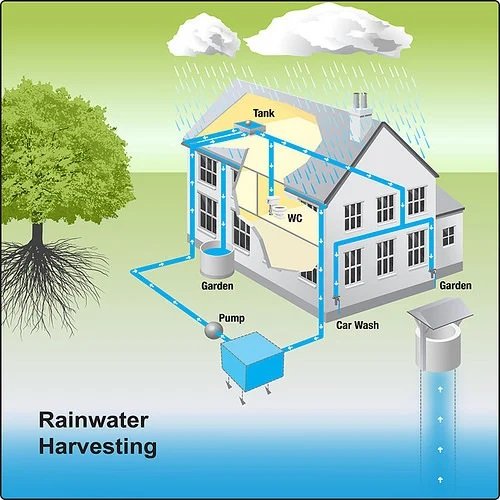In an era where water scarcity is becoming increasingly pressing, rainwater harvesting stands out as a beacon of hope for sustainable water management. By capturing and storing rainwater, this age-old technique conserves a vital resource and offers numerous environmental and economic benefits.
Understanding Rainwater Harvesting
Rainwater harvesting involves collecting, storing, and using rainwater that falls on rooftops, pavements, and other surfaces. This method can range from simple systems like rain barrels to more complex setups with storage tanks, filters, and distribution systems.
Environmental Impact
The ecological advantages of rainwater harvesting are multifaceted. Firstly, it reduces the demand for existing water sources, easing the strain on freshwater reservoirs and underground aquifers. This lessens the need for energy-intensive water extraction processes, such as pumping from deep wells.
Moreover, capturing rainwater before it flows into storm drains helps prevent soil erosion and reduces the risk of urban flooding. This practice also minimizes pollution, as rainwater runoff often carries pollutants like oil, chemicals, and debris, which would otherwise contaminate waterways.
Benefits and Applications
The applications of rainwater harvesting are diverse and extend across various sectors. In households, collected rainwater can be used for landscaping, flushing toilets, and even as a potable water source with proper filtration and treatment. For agricultural purposes, it is an excellent irrigation alternative, especially in regions with limited water access.
Implementation and Challenges
While the concept of rainwater harvesting is promising, its widespread implementation faces challenges. Education and awareness campaigns are essential to encourage adoption at individual and community levels. Additionally, factors like initial setup costs, limited space for storage, and regulatory constraints can hinder its uptake.
However, technological advancements, incentives, and policies supporting water conservation can significantly mitigate these challenges. Governments and organizations worldwide increasingly promote rainwater harvesting through subsidies, tax rebates, and regulatory frameworks, thereby incentivizing its adoption.
Here’s an in-depth exploration of the different techniques used to store rainwater:
Rain Barrels and Tanks:
- Rain Barrels:These are the simplest forms of rainwater storage. Typically made from plastic or metal, rain barrels collect water from gutters or downspouts connected to rooftops. They store relatively small quantities of water and are ideal for residential use, such as watering gardens or washing cars.
- Storage Tanks:Larger storage tanks made from polyethylene, fibreglass, or concrete can hold significantly more rainwater. These tanks can range from hundreds to thousands of gallons in capacity, catering to various purposes in both residential and commercial settings.
Cisterns:
- Underground Cisterns:These are buried beneath the ground and can store substantial amounts of rainwater. They offer benefits like protection from temperature fluctuations and reduced algae growth due to reduced exposure to sunlight. Underground cisterns are suitable for larger-scale water storage, including residential, commercial, and community applications.
- Aboveground Cisterns:These are visible containers usually made of concrete, plastic, or metal placed above the ground. They are easier to install and maintain than underground cisterns but might be more prone to temperature variations.
Ponds and reservoirs:
- Ponds:Artificial ponds or dugouts can serve as large-scale storage solutions for rainwater. They are commonly used in agricultural settings for irrigation purposes.
- Reservoirs:Constructed reservoirs, either natural or artificial, are significant water storage systems used for community water supply, agricultural irrigation, and industrial purposes.
Rain Gardens and Swales:
- Rain Gardens: These are planted areas designed to absorb and store rainwater, promoting infiltration into the soil. They store water, help reduce soil erosion, and replenish groundwater.
- Swales: shallow depressions or channels designed to slow, spread, and absorb rainwater runoff. Swales can be incorporated into landscapes to capture and store rainwater, allowing it to percolate into the soil.
Challenges and Considerations:
- Maintenance: Regular cleaning, debris removal, and maintenance of storage systems are crucial to prevent contamination and ensure optimal functioning.
- Space and Cost: The size and installation cost can vary significantly based on the chosen storage method, making assessing space availability and budget considerations essential.
Conclusion
Rainwater harvesting presents a sustainable and viable solution in the global quest for water security. Its practice conserves water and fosters self-reliance and resilience against water scarcity challenges. With continued innovation, advocacy, and collaboration, rainwater harvesting can play a pivotal role in shaping a more water-conscious and sustainable future for future generations.

